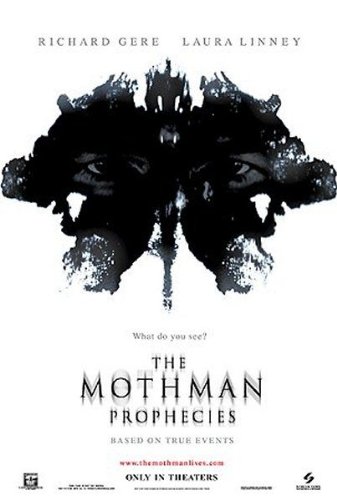
Audiences had no idea what they were in for when THE MOTHMAN PROPHECIES hit theaters in the winter of 2002. Once marketing for the film was underway, the mythical (?) and titular antagonist of the film effortlessly achieved a shape and rictus based on the title alone; audiences concocted in their mind a hulking and unnatural monster that was man-shaped, but sprouted wings and towered over even the tallest person who had claimed to see the monster with their own eyes. The opening weekend of THE MOTHMAN PROPHECIES followed, by less than five months, another horror film that featured a “similar” monster, insofar as the limited imaginations of audiences allowed. It was called “the Creeper,” from the very, very stupid JEEPERS CREEPERS, about a naked mutant bat man making arts and crafts out of human skin, Buffalo Bill-style. Compared to its more visceral colleague, it’s safe to assume that audiences just weren’t ready for the abstract and ambiguous horrors of THE MOTHMAN PROPHECIES, which snuck into theaters under the guise of being a more traditional monster movie and was something else entirely.
John Klein (Richard Gere) is a reporter for The Washington Post who lives in Georgetown with his gorgeous wife, Mary (Debra Messing). In addition to his role as a reporter, he casually appears on a national television show called “D.C. Review” to discuss politics. Because of his career, the Kleins seem to be doing quite well, financially — especially since the film opens with the couple shopping for a new house. They share a good life, and their love is genuine.But this life they’ve built together, and the future they dream of with infectious enthusiasm, all comes crashing down one cold night as the couple drives home after picking out their dream house. A flash of something murky with glowing red eyes flies at the car with immense speed and causes Mary to lose control at the wheel. Her head cracks against the window with a sickening shattering of glass, and John immediately rushes her to the hospital, where she, seemingly delirious from the accident, asks John, “You didn’t see it, did you?” Assuming that she’s in shock from the accident, he can only tell her no, and ask her what it is she thinks she saw. The question seems impossible to answer, and tears fill her red, terrified eyes. John goes back to the scene of the accident to see if he can locate the “it” of which Mary speaks. He sees only some glowing red lights atop a construction barrier… and a V-shaped layer of burn residue on the car’s grill.

Mary soon passes away (on Christmas Eve no less) — not from the accident, but from the incredibly rare brain tumor growing inside her, and had only been discovered during routine hospital tests following the accident. A notebook found in her hotel room features frantic and hand-scrawled sketches of “angels,” as an orderly describes…but these drawings don’t look angelic at all. They show a dark figure with angry features and wings like a butterfly.
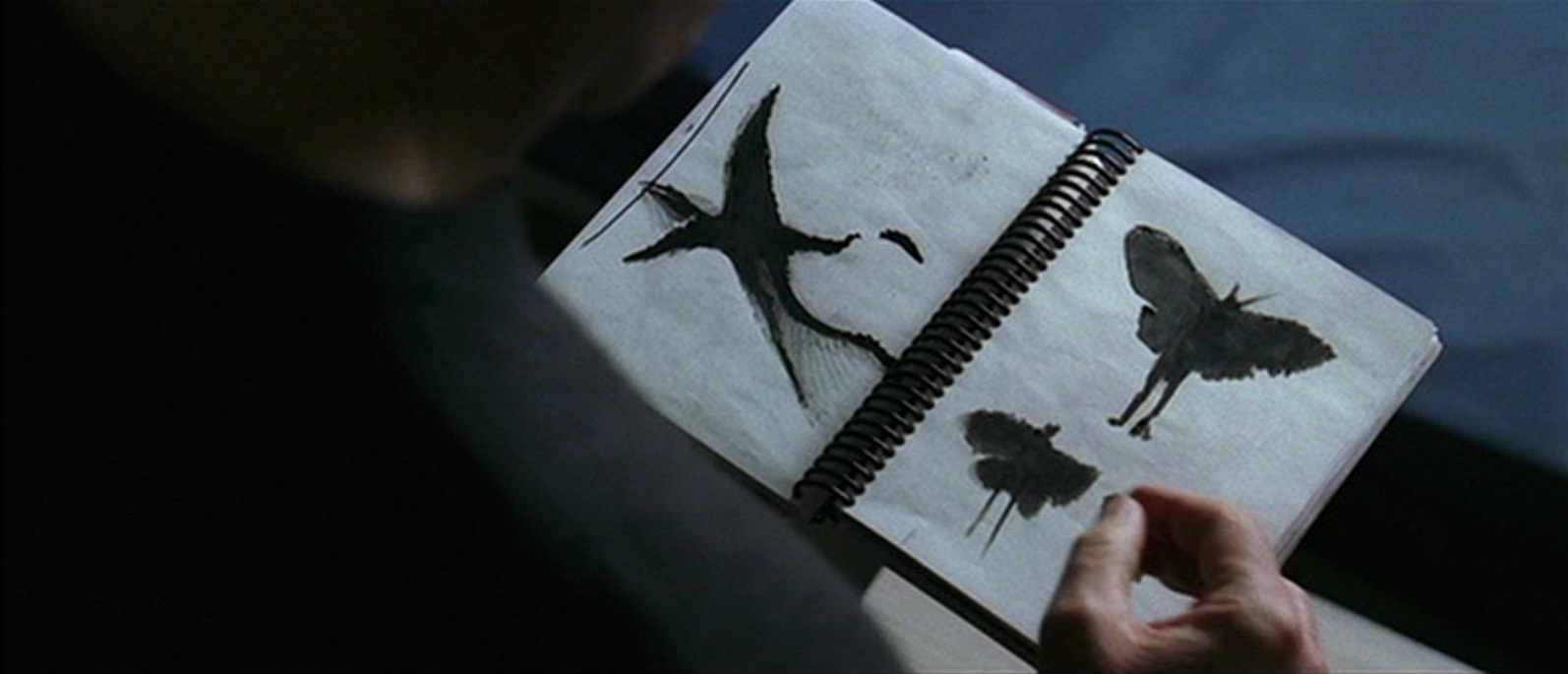
Two years pass. John remains isolated and melancholic, turning down offers from friends for blind dates. He smiles as he declines, pretending to be amused by the prospect instead of outright destroyed; his sadness is paramount. An impromptu late-night drive to prep for an interview with the Virginia governor begins Klein’s journey into the world of Indrid Cold, aka the mothman. It begins in Point Pleasant, West Virginia, where he meets Connie Mills (Laura Linney, THE EXORCISM OF EMILY ROSE), a police sergeant, after a surreal “misunderstanding” at the home of a local named Gordon Smallwood (Will Patton, HALLOWEEN 2018.) You see, after Klein’s car broke down just outside Gordon’s house at 2:30 a.m., he knocked on the door to see about using their phone. He has a shotgun shoved in his face for his troubles and is forced into the bathroom (which is a somewhat creepy place to force a man you’ve captured, once you realize it would be the easiest place to clean…should someone get their head blown off). But instead of Gordon being the “bad guy,” he immediately calls Sgt. Mills and explains to her that Klein has apparently knocked on his door the past two nights, at the same time, asking to use the phone. Even though the audience and John know that’s not true, Gordon seems to believe it intensely. But how could that be? How can John have been in two places at once? How is it John impossibly traveled over 400 miles in just 90 minutes when ordinarily it would have taken six hours? How did he end up in damn-near Ohio when he was aiming for Richmond, Virginia? Just what the fuck is going on in Point Pleasant?
And so it begins.
John and Connie begin to compare notes. She explains that Point Pleasant has been plagued for the past month or so with weird sightings and complaints—of “mothlike” figures with “red eyes,” strange lights,and phone calls filled with high-pitched electronic shrieks. After visiting one of the eyewitnesses, John sees burn residue on a nearby tree that matches what he saw on their car the night of Mary’s crash. And the witness descriptions of the figure itself seem to match Mary’s sketches beat for beat. Whatever’s going on in Point Pleasant has John’s full attention.
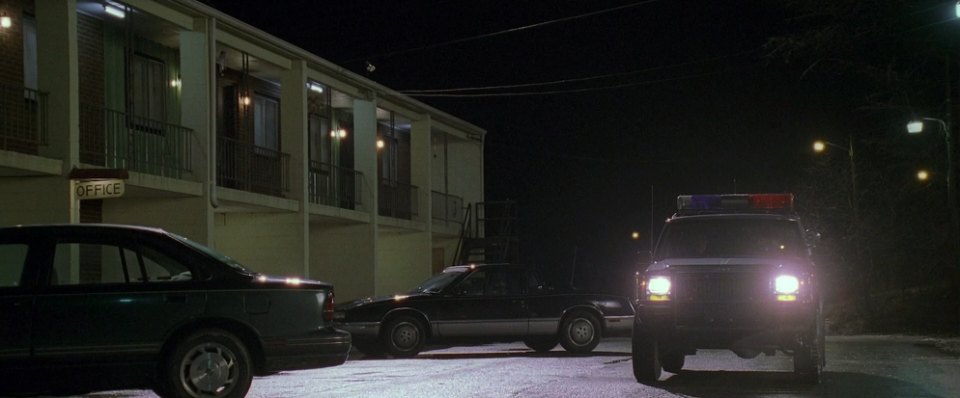
John and Gordon begin an uneasy friendship. They begin to depend on each other, trying to figure out this puzzle that the mothman has created. What is it? What does it want? Is it even real?
One night, Gordon claims to see a reflection in his bathroom mirror that is not his own, and a howling voice coming out of his sink drain that says the same words over and over for an hour: “Do not be afraid. 99 will die. Denver 9.”
The next day they see the news report: a plane flying out of Denver, Concorde 9, has crashed, killing all 99 passengers.
For whatever reason the mothman seems to be warning people of impending disasters, which on the surface doesn’t seem to be something to fear. So then why is the mothman so haunting and strange? Why have people been left physically harmed from its presence?
John seeks out a man named Alexander Leek (a meta-pseudonym for John Keel, author of the book which inspired THE MOTHMAN PROPHECIES.) Leek is a paranoid, afraid, and unstable man. He’s aware of the mothman and of its repertoire. He explains that the mothman doesn’t have one form — that it appears in certain ways to certain people based on their ability to perceive what they are seeing. He describes it as an advanced being, observing our lives from afar. John demands to know why the mothman doesn’t just come down and explain itself, and make clear what it wants. Leek responds, “You’re more advanced than a cockroach. Have you ever tried explaining yourself to one?”

THE MOTHMAN PROPHECIES, from the first minute to the last, is draped in an incredibly palpable feeling of eeriness. It doesn’t let up, even in the lightest moments of the film. And the mothman, though never clearly seen beyond quick flashes and fuzzy recollections, is a constant presence. He hovers outside every window, diving in and flying away. The camera moves fluidly to achieve this feeling, especially when swooping rapidly from behind John as he sits in a desolate park. John turns, sensing something behind him, but of course, he sees nothing.
One of the most underrated modern directors of our time, Mark Pellington deserves more recognition, and to be working on a lot more high-profile projects.(In recent years he was attached to the English-language remake of EL ORFANATO (THE ORPHANAGE), though his last statement on the matter seemed to suggest that New Line has canned the project after taking too long on getting it started.) Many directors are accused of exhibiting only style over substance (Zack Snyder comes to mind), and while that may be also true of Pellington, that’s only because the man hasn’t been given enough chances to show what he’s got. THE MOTHMAN PROPHECIES received so-so notices from critics as well as middling box office returns (though his direction would be praised by Roger Ebert, who lamented that his tremendous skills behind the camera had been wasted on a sub-par screenplay).
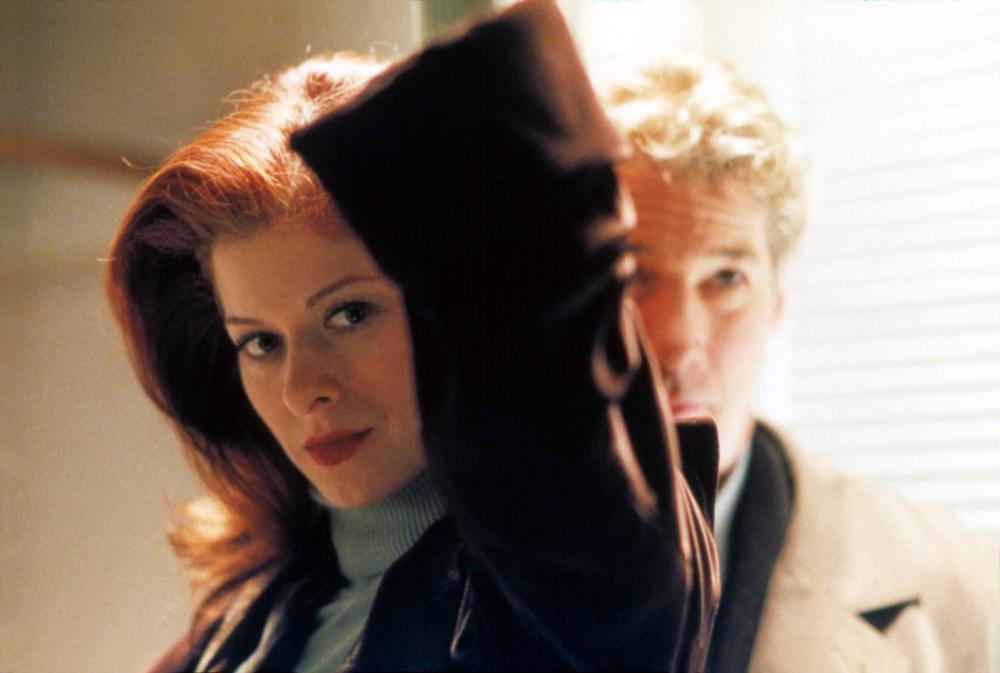
Pellington’s direction in THE MOTHMAN PROPHECIES is the strongest of his career, which also includes the terrorist thriller ARLINGTON ROAD and the drug-addled drama I MELT WITH YOU. For THE MOTHMAN PROPHECIES, he takes a not-so-traditional concept for a horror movie, steeping it in paranoia and mood, and drenches the film in bleak tones. Pale blues and stark whites litter the screen, and he shoves the bone-crunching harsh winter of Point Pleasant directly into your face. Cold weather has always been intrinsically more effective for a horror film (THE SHINING, THE THING), and the harsh winds and shorter days drive Point Pleasant citizens off the streets and into their houses, leaving the town at night seemingly deserted.
Pellington uses the camera to invoke the presence of mothman whenever appropriate. The camera doesn’t move as it has in other films; it starts at ground level and hovers around people’s faces, as if constantly moving around to study them, before shooting off into the sky. It swoops in on John as he stares forlornly out a skywalk window — and before he is whisked away by a doctor, the camera moves just as quickly away again, as if taking off back into the night.
Eyewitness accounts of Indrid Cold are painted with swirling and red-tinted light, and each recollection of the encounter are simplistically but eerily effective. There are several sequences peppered throughout the film that pull you in and give you the chills, regardless if you’ve let the film take you where it had intended. The most effective sequence in the film has Klein alone in his dingy and dark motel room, and Indrid Cold calling him on the phone. Klein, for personal and obsessive reasons that have nothing to do with all he has learned, but everything to do with his deceased wife, refuses to believe Indrid is the mythical figure everyone in Point Pleasant seems to believe. And so Klein rushes around the room, testing Cold’s so-called omniscience:
Where is my watch?
In your shoe…under the bed.
What’s in my hand?
Chaaaapstick.
[grabbing a book] Third line, page fifty one?
“A broken smile beneath her whispered wings.”
They are things Indrid couldn’t possible know, but he somehow does. It’s one of my favorite scenes in any film, grippingly directed with feverish and chilly eeriness.
Based on the “non-fiction” book by John Keel, screenwriter Richard Hatem created a more traditional narrative, featuring characters we could follow in order to experience the strange goings-on of Point Pleasant. The events featured in the film allegedly took place during the 1960s, but were updated to then-present times for the 2002 film. From what I’ve learned about mothman from other sources (there is an exhaustive, almost three-hour documentary called EYES OF THE MOTHMAN, which tells you everything you’ve ever wanted to know), THE MOTHMAN PROPHECIES includes many of the events that were said to have taken place in Point Pleasant.

Richard Gere, long known as a pretty boy and rom-com stalwart, offers a praiseworthy performance. He plays a man so emotionally stricken by the death of his wife that he falls effortlessly into the hands of Indrid Cold, who uses Mary’s image to fuck with his mind. His performance is split right down the middle, maintaining his objectivity as an investigative journalist, but also allowing himself up be swept up into the town’s paranoia and outright fear of this mystical figure. Klein is emotionally invested in the town’s victimization as well as his own personal heartache, but at the same time, he sees a mystery that needs to be solved, so much that he’s willing to abandon his position at The Washington Post. His obsession with the mothman fuels him and gives him purpose, because to him, it’s not just about finding out who this “man” is, but really finding out what he had to do with his wife’s death… if he even did. It’s an interesting conflict, in that we, as the audience, don’t know when the investigation stops being objective and starts becoming personal.

As usual, Laura Linney is typically wonderful. In this day and age, actors are woefully miscast for their roles, taking on characters for which they are not suited, but Linney believably embodies a small-town citizen who knows all her people by name. In the film, she is strong and intelligent, but never abandons the soft side that the audience as well as Klein depends on. Linney isn’t set up as the generic romantic interest… just a potential one. In the last act of the film, it’s clear that Linney cares for John. What’s unclear is the kind of companionship she is offering him. Is she there for him as a friend? Or more? The audience is never let in on that secret, but what we do know is it’s up to Klein to answer the phone, while his dead wife allegedly waits on the other end.
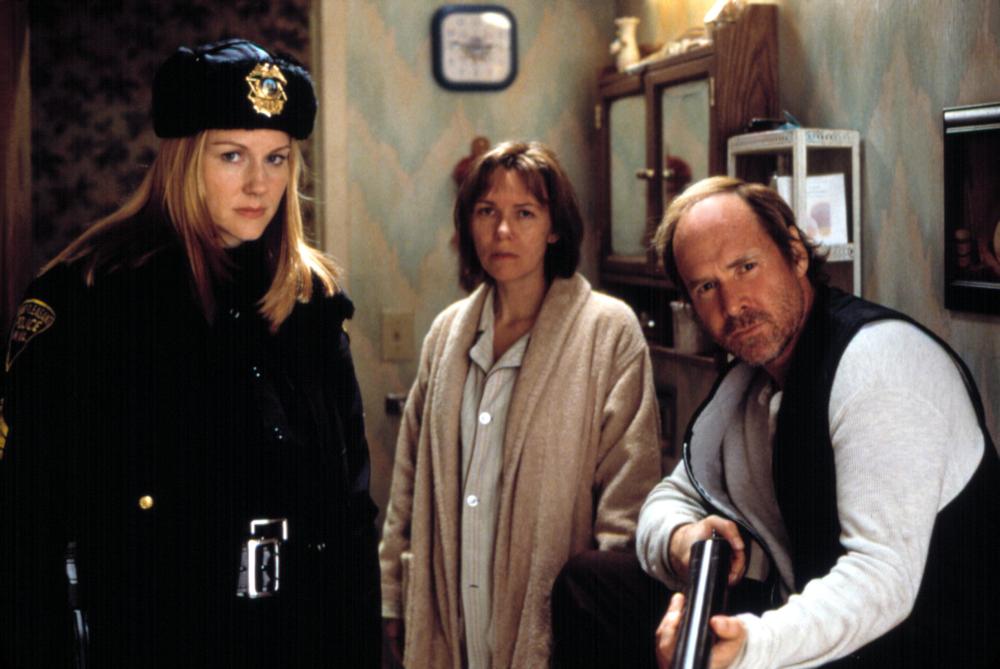
Will Patton is among my favorite character actors, and his career has touched down in almost every genre: horror/thriller with COPYCAT and this year’s HALLOWEEN, action with ARMAGEDDON, and drama with BROOKLYN’S FINEST (again with Gere). His role here is quiet and understated, but extremely evocative of fear. He doesn’t just look afraid — he is afraid. He speaks in whispers, as if fearful that Indrid Cold will hear him and come looking for him.
The score by tomandandy is appropriately droning and moody. There’s not much musically going on with their score, but that doesn’t mean it’s not an effective one. Every inch of the film is tinged with their electronic humming, brimming with psychedelic and unusual choices…and it all comes to a head at the bridge finale, where their pulse-pounding music makes the sequence ten times more powerful. (Seriously, if you don’t have chills throughout this entire sequence, you’re not alive.)

While it’s understandable that people might not like THE MOTHMAN PROPHECIES, it’s also not condonable. No, it’s not your typical rubber-suit monster streaking through town and punching off heads. It doesn’t swoop down from the skies and clutch a baby in its talons before disappearing into the night. Mothman’s presence is psychological. It takes the form of other people to get inside your head. The human race is a rat in a maze, and the mothman gets its rocks off on providing us with information and seeing how we react. Yes, the mothman does warn of impending disasters, but we never get the sense it’s because of the goodness of its heart. It’s more that it wants to see if we’re smart enough to recognize the hints it leaves us; it wants to see what choices we make; it wants to see if the human race is worth the mark we’re leaving on the universe.
Modern movie audiences don’t like ambiguous films, and even less, ambiguous endings. Sure, they love the film if it’s something like INCEPTION, where people shoot guns and float around for hours at a time, because it’s provided all the thrills necessary for a typical mainstream film. But THE MOTHMAN PROPHECIES is a slow burn. It starts off as a slow burn, and except for the wonderful and heart-pumping bridge climax, it remains a slow burn. Most people just don’t have the patience for films that take their time, but for those that do, I’m confident that THE MOTHMAN PROPHECIES is a film that will remain effective for years to come.
Tags: Alan Bates, Bob Tracey, David Eigenberg, Debra Messing, Horror, John Keel, Laura Linney, Lucinda Jenney, Mark Pellington, Richard Gere, Richard Hatem, tomandandy, Will Patton


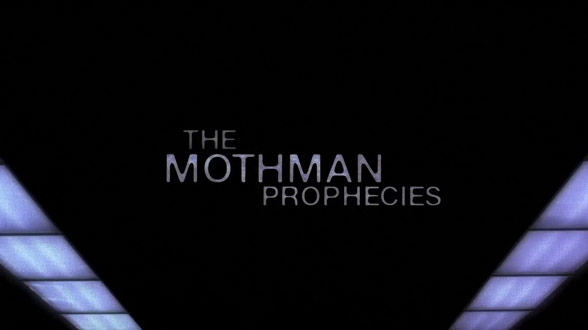
No Comments